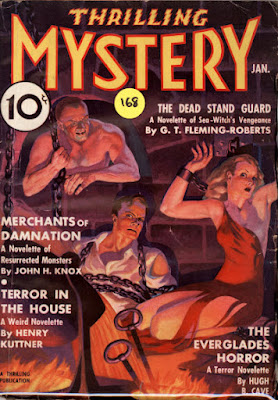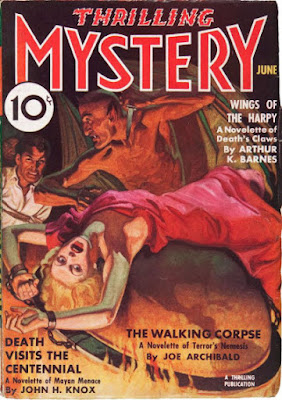I have to return my interlibrary loan copy of the Henry Kuttner collection Terror in the House soon, so let's read four stories penned by Kuttner that have awesome titles and appeared in Thrilling Mystery in 1937. Is there any chance they can live up to those titles? The fact that none of these stories were reprinted until 2010 may provide a clue, but we're going to read them anyway.
"The Faceless Fiend"
Kuttner had two stories in the January 1937 issue of Thrilling Mystery, "Terror in the House" under his real name and this story under a pen name.
Harvey is walking to his fiancé Isabel's place on a foggy night. (These stories are so often about some guy with a fiancé, it must say something about the audience to whom they are trying to appeal to or something... maybe gender studies types would say it reflects the inherent conservatism of these stories which outwardly may appear so crazy, that they and their readers take for granted conventional ideas about family formation and seek to perpetuate traditional ideas about the forms sexual relationships should take, even as they appear to be pushing the limits of what can and should be published...you know how college professors talk.) Harvey suddenly smells rotting flesh, and is attacked by a strange character--a man with no features on his face save for a single eye! The one-eyed man is remarkably strong and agile, rendering resistance futile; Harvey is about to expire when his fiancé and her brother Russ appear with a flashlight, driving off Harvey's assailant flee. Russ, who comes across as a real jerk, scoffs at the idea that a cyclops tried to murder Harvey, dismissing this traumatic event as no more than an attempted stick up by a man in a mask. No biggie!Russ the jerk works in a museum that is past its sell by date--Kuttner tells us it was "built before the war" and smells so bad it has very few visitors. Isabel sometimes helps Russ with his work there, and the next day Harvey accompanies the brother and sister to this unpopular smelly museum, where we hear how a month age the night-watchman was found murdered and meet two oddballs to add to the list of suspects currently headed by Russ: the curator who seems to have a crush on Isabel, and the anti-social professor who manages the Egyptian room.
The plot of this story advances very quickly once we get to the malodorous museum. The cyclops reappears, attacks the curator, who survives, and then Russ, (who I thought was our prime suspect--sorry Russ!), who dies, and then carries off Isabel, whose shirt comes open during the fracas. Harvey gives chase and ends up in the Egyptian room, where he finds that the professor is in command of the monster. Like all bad actors, he tries to shift responsibility for his actions to somebody else, claiming it was the curator who made him use the cyclops to commit robberies. Then the curator appears, waving a gun, and forces the prof to narrate the series of events that has lead to this curator vs prof showdown.
The cyclops, whom the prof and curator call Adam, is a veteran of the war in Europe who was severely injured in an explosion; besides having his face torn off, his brain was damaged. (Kuttner used this same gag in "Bamboo Death.") The prof, who I guess also has some kind of medical expertise (in fiction a scientist or academic often has deep knowledge of several disciplines, which is not what I found in my own abortive academic career--the academic men and women I met were much like men and women I meet everywhere, the men primarily interested in sports, video games and TV shows and the women primarily concerned with babies, fashion and TV shows), tried to ease this poor bastard's pain with drugs and hypnotism. The diabolical curator, however, saw in the brain-damaged and easily manipulated Adam, with his powerful physique, the perfect cat's paw, a dupe who would commit robberies and even murders on command. The curator, getting creative, put some goop on the mentally ill veteran that made him smell like rotting flesh, thinking it would make the guy more scary. Feeling a curator's compensation was unfairly meagre, the curator directed Adam to commit robberies, and because he was in lobe with Isabel, directed the one-eyed man to kill Harvey. The prof, seeing things getting totally out of hand, tried to escape this sticky situation by ordering Adam to murder the curator and any witnesses, leading to the death of Russ and to this showdown.
In the ensuing fight all three of these wacky characters--Adam, the prof and the curator--join Russ in death. Harvey and Isabel are injured, but survive. Kuttner leaves to the reader's imagination the questions of who is going to take over the museum and whether he or she will be able to secure a grant to deodorize the place.
Weak filler--the plot is too complicated and people's motivations are hard to take seriously, and there is nothing crazy enough to really make you sit up and take notice.
"The Dweller in the Tomb"
Jim Mason, our narrator, is on his honeymoon with blue-eyed Lucille in eerie old England. In Sussex they stop at a castle in which Jim's Uncle Argyll now lives with his assistant, Frank Kent. Uncle seems mighty pleased about this surprise visit!Uncle Argyll, like so many people in horror stories, is a student of the occult. It's not long before he's got a gun aimed at Frank, Jim and Lucille (Lucille dressed for the occasion in a filmy negligee) and is forcing them to go down into the dungeon, to the lowest vault, the seventh, because he wants to sacrifice them to the monster that is entombed under the castle--this monster is a Druid priest who learned the secret of eternal life and has been half alive down under a barred circular hatch for centuries. Uncle Argyll believes that if he feeds the monster three people it will become his slave and teach him Druid magic.
Argyll forces Frank to open the round door and the monster, a thing with no face that drips slime and has crab-like claws, emerges. Uncle Argyll strips Lucille naked and throws her down to the monster. But the monster ignores her and attacks Uncle Argyll. Uncle Argyll dies of cardiac arrest and then Frank shoots the monster with a gun he gets from someplace. As it dies, the monster curses Frank out in modern English.
I groaned as Frank revealed the truth. Frank's father was cheated out of all his money by Argyll years ago and committed suicide. So Frank became Argyll's assistant and plotted a complicated revenge. He built the fake tomb under the castle, hired a guy to wear a monster outfit, and convinced Argyll to buy the castle by giving him forged ancient documents describing the Druid monster. Frank thought the monster attack would drive Argyll insane, not kill him, and that he (Frank) could save the day by shooting down the monster, and then act as surprised as everybody else when the monster turned out to be an imposter. But when the imposter lived long enough after getting perforated to talk, the jig was up.
Frank tells Jim and Lucille that he has to kill them, but killing Americans isn't as easy as Frankie boy thought it would be and he ends up dead in the fight that ends the story.
I was kind of enjoying the story when I thought maybe the monster was real, and was annoyed by the reveal of Frank's convoluted and not very credible plot. Maybe that evens out to lame filler, just barely acceptable.
"Nightmare Woman"
This story makes use of Norse mythology, employing the idea of a "mara," which we are told is a "troll woman who draws life from her victims," coming to you in the night to give you nightmares. Martin Rand's fiancé Freda has a brother, Johnny, who is quite sick; growing steadily more anemic, losing strength every night! A doctor is on hand, and a nurse; the sawbones says Johnny is too sick to be taken to the hospital, that the trip would kill him! At night, a woman who glows purple is seen leaning over Johnny--when Freda and Martin try to attack the woman they fall asleep! The nurse turns up dead, all the blood drained from her body!Johnny and Freda's father believes in all kind of occult stuff, and so when a guy who says he is an expert on the occult drop in and promises to drive off the mara with his special skills and apparatus, Dad is willing to go along with this joker's offer of help, even though he wants $100,000 if Johnny recovers. Martin wants to call the cops, seeing as they have a dead woman in the house with them, but the occultist says the cops will break his concentration and he won't be able to banish the mara!
After reading "The Faceless Fiend" and "The Dweller in the Tomb" I expected that this was all a hoax, that there was no mara, and I was right. The doctor and the occultist were in cahoots with an actress wearing luminous paint; the doctor was poisoning Johnny and using a sleep drug on everybody else to simulate some kind of sleep spell. The three criminals were going to split the 100k after play acting the defeat of the mara and after Johnny's recovery. The nurse, an honest medical professional, realized something was up and so they murdered her, drawing all her blood so her death would look more supernatural.
Anyway, Martin saves the day in a boring fight.
Like "The Dweller in the Tomb" and "The Faceless Fiend," this one has a convoluted and totally unbelievable plot, but is even worse, there being no sex or monster or even faintly interesting action scene. Freda's top never even comes close to coming off! Gotta give this one a thumbs down.
"My Brother, The Ghoul"
The first three stories we looked at today are each like 14 or 15 pages long in their Terror in the House appearances. "My Brother, The Ghoul," on the other hand, is like 25 pages long, which is giving me pause: I still remember how Kuttner padded out another longish story from Thrilling Mystery, "The Power of the Snake," with totally pointless scenes.




No comments:
Post a Comment